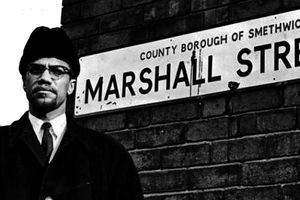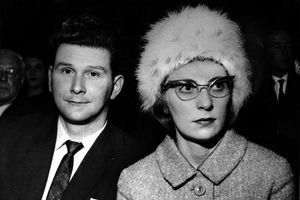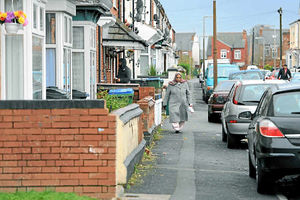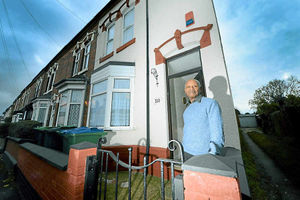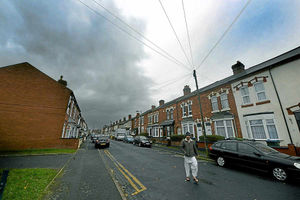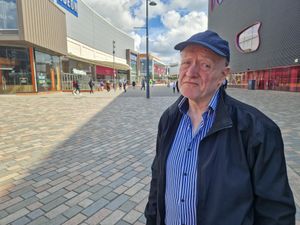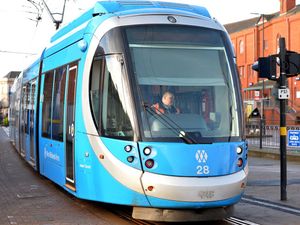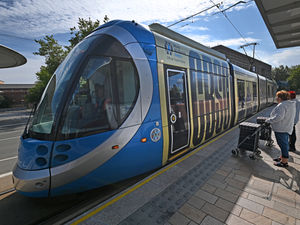Not everything is black and white - Marshall Street: Then and now
It was the street that was meant to be kept for 'whites only'. Faced with mounting tension over immigration, a council decided it would buy up any properties that came onto the market and let them only to white families.
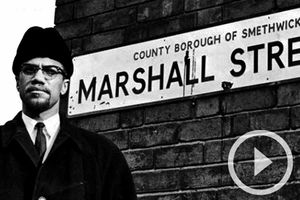
The policy for Marshall Street in Smethwick was shocking even in the 1960s, when, according to archive footage from the time, it was still considered perfectly normal for professional news reporters to refer to minority ethnic people as 'coloureds'.
And its implications for race relations was so serious that it resulted in a visit from the American civil rights activist, Malcolm X, just nine days before he was assassinated in New York.
He told reporters: "I have come here because I am disturbed by reports that coloured people in Smethwick are being badly treated. I have heard they are being treated as the Jews under Hitler. I would not wait for the fascist element in Smethwick to erect gas ovens."
It did not turn out to be the start of something as desperate or as evil as that.
But it was still something that could have changed the face of Britain forever, had the government not stepped in and quashed it.
Today, Marshall Street is home to hundreds of people with many different names and cultures. An official blue plaque, commemorating the visit of Malcolm X, is high on the wall of the end house, at the junction with West Park Road.
The Indian Workers Association had grown especially worried at the plans of Smethwick Council and invited Malcolm X to Marshall Street to see it for himself.
When Malcolm X visited the town he was described as 'an unexpected and largely unwelcome guest' in a local paper, the Smethwick Telephone and Warley Courier.
Peter Griffiths called for him to be banned altogether.
He spent most of his time in Marshall Street because of the notoriety of the housing policy.
After giving press and TV interviews, and drinking a pint of beer at one of the pubs which did not operate a ban on people from ethnic minorities, Malcolm X returned to New York where he would meet his end.
Marshall Street is in an L-shape and most of the buildings were already old even in the 60s. One end of it is fairly modern, with homes dating back just over 10 years.
The make-up of the street's residents is also very modern now – a mix of different religions and nationalities.
The electoral roll reveals surnames such as Singh, Mahmood and Akhtar living alongside Morrisseys, Adams and Middletons.
Despite its diversity now the street is forever remembered alongside the former MP for Smethwick, Peter Griffiths, who died on November 20 at the age of 85.
His campaign for election in 1964 saw him branded a 'parliamentary leper' by the then prime minister Harold Wilson.
While he was an MP he supported the plan to only let homes to white people that was drawn up by the former Smethwick Council. It came about due to mounting tension over the number of immigrants moving into the area. Councillors at the time said they had concerns that the community was becoming segregated with large numbers of immigrant families moving into homes in Marshall Street and not integrating with the white community.
They had bowed to pressure from a group of white housewives who wanted to stop any more black people or Asians moving in.
In an ITN report from the time, concerns were raised that immigrants taking homes would hurt the community.
The language used would shock people today.
The ITN report from the time. Please note that the language used may shock
One unnamed woman tells the camera: "During the last two years Marshall Street has completely fallen apart.
"We have watched it happen. And this was purely to take a stand to stop the road being taken over by coloured people.
"Only being resident in Marshall Street four and a half years, we're proud of this house that we're buying and we want to keep the road reasonably clean and fit to live in and live peaceably with the coloured people as long as it's on a 50:50 basis.
"But if all these houses that are for sale in the near future do go to coloured people, we shall definitely be outnumbered in this road."
Another resident, who was 78 years old at the time and had lived in his home all his life, said: "Their way of living is not like the white people. What they cook, there's all these fumes coming from it. I don't suppose any white people would like it."
A younger woman talks about the standard of living being 'very very low among the coloured people'.
She said: "If there were less of them perhaps and more of us then they would learn to live as we do. But as it is they're living in their own communities and the standard of living is very low."
But there appeared to be little effort made to try to help anyone other than the whites who lived there.
Derrick Saunders remembers it well. If Smethwick Council had had its way, he would not have been able to buy a house in Marshall Street.
The 71-year-old came from Jamaica in 1961 and lived in Oldbury at the time of the housing row. But he moved with his family, including his three sons, to Marshall Street 31 years go.
"I remember at the time that there was a black man who had problems getting a house here", the retired warehouseman said. "He couldn't get a mortgage.
"But it's nothing like that now. We all get along well. The Asian families invite the neighbours whenever they're having a wedding. That policy didn't happen. And the concerns about people living segregated didn't come true."
Neighbour Mohammed Khan, aged 29, said he could not imagine how such a policy could have benefited Smethwick or Britain.
He said: "People stick together because they're your neighbours. If the council had started telling people you can't live somewhere because of the colour of your skin, then that would have looked bad to other countries.
"This country buys so much stuff from abroad. You can't keep it all in one place. Even big British companies like Jaguar Land Rover are owned by Indian companies. The world's a bigger place than that."
His cousin Nayyib Mohammed, aged 18, said the children all play football together. "It's just a normal place to live," he said.
The Smethwick seat that Peter Griffiths once won is now part of the Warley constituency held by Labour's John Spellar.
He said a shortage of housing was an issue for everyone regardless of race.
"Sandwell Council has a policy where you have to have either lived here for five years or have a family connection to the area in order to be considered for council housing.
"Housing supply would be a concern to everyone, regardless of race, because people need to know that they can live close to their relatives.
"What the council of the day and Peter Griffiths did was to enflame the issue rather than try to resolve it and bring people together.
"But it hasn't lasted.
"Smethwick is a model for the way different communities can live together and get along with each other." In the 1960s, Smethwick attracted workers from the West Indies and Indian sub-continent.
The came for exactly the same reason that Welsh immigrants arrived during the last century, and French Huguenots before them.
The foundries were booming and there was always work for people who were prepared to put in long hours for low pay.
As a result, Asian workers did more for less than their white counterparts.
It did not go down well in the pubs and clubs.
While the Labour party was quick to condemn Mr Griffiths, Smethwick Labour Club imposed a well-publicised colour bar.
Yet the fears expressed by the likes of Councillor Gould, and backed up by Peter Griffiths, were not shared by all, even just a few short years later.
Mahboob Hussain arrived from Pakistan with his family as a 10-year-old in 1970 and grew up in Bromford Road, Oldbury. He said: "I remember there was an African Caribbean family on one side and a white family on the other.
"The neighbours would say hello and if they didn't see me in the garden for a few days they'd ask how I was.
"I think there are always going to be cases where people do not get along. That's the same in a community as it is within your own family."
Mr Hussain went on to be elected as a councillor himself in 1995, chosen by an electorate where 87 per cent of people were white.
"I have never felt anything other than welcome by the community", he said.
"Even after the September 11 attacks of 2001, that did not change. I was concerned that having a name like Hussain would have caused me problems but it didn't.
"The majority of people just aren't like that."
Council wanted housing for whites
The message was one apparently of harmony in a divided community, but it proposed the very opposite.
Councillors in Smethwick had drawn up a policy of buying all the houses that became available in one street – and keeping them only for whites.
Even considering the views on race relations of nearly 50 years ago it was shocking.
This was not simply a stringent requirement to have lived in the area or to have relatives close by.
Here, in 1964, was a local authority effectively saying that the colour of someone's skin, or the place where they were born, would preclude them from a home even if they were working for a living and paying tax in Britain.
The policy prompted national headlines and brought television news cameras to Smethwick.
In the clipped and accent free English tones of the age, an ITN reporter asked the chairman of the town's housing committee, Councillor Ernest Gould, where the 'coloured people' would go if they could not get a home in Marshall Street. Councillor Gould, with his Black Country accent, replied: "That isn't our problem. That is the problem of the immigrant himself.
"What we do think that this road must not be completely taken over by immigrants. We think this would be segregation and that is the last think we want if we want the coloured people to settle down among the white residents of this road."
The national government stepped in and the plan ended up being outlawed by the Ministry of Housing. In the black and white footage of the ITN report, it was claimed that 'Whites don't mix with coloureds, Sikhs don't mix with Jamaicans'.
The reporter adds: "The whites say they want to keep the proportions of coloureds within bounds, so they can help raise their standards of living to the British level. But so far, with six years of coloured neighbours, nothing has been done."
While Peter Griffiths was the MP for Smethwick, he was also a council alderman and it was he who arranged for the authority to buy up the houses, with the aim of stopping Marshall Street becoming a 'ghetto'.
But the plan was torpedoed by the national government of the day.
